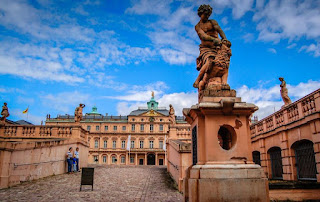Although uprisings in Germany during the late 1840s were suppressed by the forces of reaction, their ultimate goals were eventually realized. Baden had been the scene of the first of the 1848 uprisings in Germany, which helped to set the stage for the rise of a more modern, unified Germany, in 1871 .
=================================================================(in the German state of Baden-Württemberg) A city with a baroque core, Rastatt is found in the Upper Rhine Plain on the Murg River, six kilometers (~4 mi.) above its junction with the Rhine. An important place associated with the early-18th-century War of the Spanish Succession (the Treaty of Rastatt was signed here), as well as the Revolutions of 1848/1849 in the German states. Until the end of the 17th century, Rastatt held little influence, but after its destruction by the French in 1689, it was rebuilt on a larger scale by Louis William, margrave of Baden, the imperial general in the Habsburg-Ottoman War, known popularly as Türkenlouis. It then remained the residence of the margraves of Baden-Baden until 1771. It was the location of the First and Second Congress of Rastatt, the former giving rise to the Treaty of Rastatt. In the 1840s, Rastatt was surrounded by fortifications to form the fortress of Rastatt. For some 20 years prior to 1866, it was occupied by the troops of the German Confederation. The Baden revolution of 1849 began with a mutiny of soldiers at Rastatt in May of that year under Ludwik Mieroslawski and Gustav Struve, and ended here a few weeks later with the capture of the town by the Prussians. For years afterwards, Rastatt remained one of the strongest fortresses of the German empire, but its fortifications were dismantled in 1890. Between 1946 and 1954, about 20 major criminal proceedings (known as the Rastatt Trials) for crimes against foreign workers and prisoners in smaller camps in the National Socialist camp system in southwest Germany took place in front of the French Military Administration's Tribunal Général, along with more than 2,000 defendants. Today, Rastatt and its surrounding area -- in the vicinity of the Black Forest and the French border -- is home to a variety of historical buildings, including palaces and castles such as Schloss Rastatt and Schloss Favorite. Featured here is Schloss Rastatt, a historical structure in Rastatt. The palace and the garden were built between 1700 and 1707 by the Italian architect Domenico Egidio Rossi, as ordered by Margrave Louis William of Baden. During the Palatinate War of Succession (from 1736-1742), the residence of Margrave Louis William of Baden-Baden had been burned by French troops. A rebuild of the destroyed building would not have suited the representative needs of the court of Baden-Baden. Since he also needed a home for his wife Sibylle Auguste of Saxe-Lauenburg, whom he had married in 1690, the Margrave had a new residence built in place of the former hunting lodge. During this operation, the 1697 hunting lodge was demolished to leave space for the new palace.





No comments:
Post a Comment